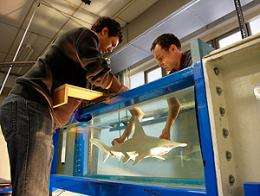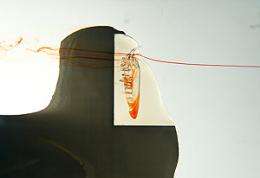Researchers investigate fishy sense of smell (w/ Video)

(PhysOrg.com) -- As every Jaws fan knows, sharks can smell a drop of blood from up to a kilometre away, but how are their noses so sensitive?
Research led by the University of Bath is using the latest technology to find out how these fish are able to sniff out their prey.
Dr Jonathan Cox from the University’s Department of Chemistry has been working with researchers from the University of Cambridge and the Natural History Museum in London, testing a scale model of a hammerhead shark in a flow tank to see how the water flows around the nasal cavity of its strange flattened head.
The researchers did a CT scan of a shark’s head from the Natural History Museum’s collection. The scan was used to make an accurate model of the head and nasal cavity with a 3D printer. The model featured recently on BBC2’s Museum of Life series about the Natural History Museum.
This is the first time a detailed model of a hammerhead shark’s head has been made to study the creature’s amazing sense of smell. The research is published this month in the scientific journal Comparative Biochemistry and Physiology.
Dr Jonathan Cox said: “Whereas humans use their lungs like a bellows to inhale air through their noses to smell, the hammerhead shark smells as it swims forwards, propelling water through its nose.
“The nasal cavity of the hammerhead is like a labyrinth of pipes, with a central U-shaped channel and lots of smaller channels leading off it. The smaller channels contain the olfactory receptors, and so we’re looking at how the water flows through these channels as the shark swims forwards.
“Sharks sweep their heads from side to side when they swim, so to simulate this we change the angle of the head model in the tank and observe the flow at each angle.”

Dr Timothy Nickels, Reader in Experimental Fluid Mechanics at the University of Cambridge said: “We are really excited to be involved in this project - it’s a perfect example of the strength of interdisciplinary research, with Jonathan providing the in-depth knowledge of shark olfaction whilst we contribute in measuring and understanding the fluid mechanics side of the processes.
“It turns out that our skills and facilities are ideal for this work although, until Jonathan came along we had no idea about this area of research. We’re looking forward to developing this collaboration further in the future.”
Dr Richard Abel, from London’s Natural History Museum, added: “This exciting study manages to combine cutting edge 3D imaging of 200-year-old museum specimens, with wild observations of living sharks and experimental flow research to determine how hammerhead nostrils function. The findings will aid the design of green bio-mimetic technology.”
The scientists hope their research could be used in the future to design chemical sensors for underwater exploration, medicine and counter-terrorism.
Provided by University of Bath

















